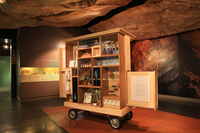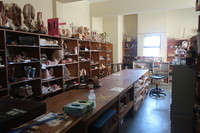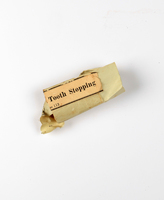Items
keywords is exactly
dentist
-

Chest: a botanical ecology
Illness and disease affect us all. The treatment of these conditions however, has been vast and varied, depending on the historical periods and the cultural context in and during which they are practiced. Situated in the rock art gallery, where healing power is expressed in San paintings, this mobile set of cabinets explores a rich complex of healing practices through the display of a medicine chest which was donated to the university of Cape Town in 1978. This chest belonged to a British dentist, who practiced in Cape Town from 1904, and who bought the chest for a hunting trip he undertook in 1913 to (then) Northern Rhodesia. The idea of the chest then gives rise to a variety of forms of healing: from instruments used to exorcise evil spirits and children's letters written to celebrate a heart transplant; to medicinal flowers bought at the Adderley Street flower market. The exhibition aims to visualise and materialise illness and its treatment from historical, cultural and disciplinary perspectives. Drawing on well-established historical and contemporary connections between the disciplines of Botany, Medicine and Pharmacology, the exhibits also suggest latent links which are at times political, at times whimsical. -

The workshop
"Held in the Department of Human Biology in the Division of Clinical Anatomy and Biological Anthropology, this collection consists of prepared specimens – both bottled and plastinated, anatomical models – and a skeletal repository used for research purposes. The materials are kept in three separate rooms, with the anatomical models in one, the prepared and plastinated specimens in another and the skeleton repository in its own room behind locked doors, viewable by appointment only. The room housing the anatomical models functioned as a workshop when modelmaking was still offered to first year medical students as an elective course: its walls are lined with shelves that display models made from materials ranging from papier-mâché to modern silicon copies and are taxonomised according to their anatomical representations, such as ‘the eye’, ‘head & neck’, ‘dentistry’, ‘embryology’, ‘lungs’ and ‘cardiovascular system’, to name a few. The models represent each anatomical section and are brightly coloured to differentiate the different parts of the human body and aid in identification. Many of the models can be dismantled into separate pieces and, like a puzzle, be reassembled into their original shapes. Interspersed with these models are rolled-up charts depicting organs, bodily systems and anatomical sections of the body in two-dimensional form, as well as old student modelling projects. A selection of animal skeletons is displayed on the far side of the room, and a shelf with a few anatomical specimens in formaldehyde is across from it" (Liebenberg 2021: 121 - 122). -

A teeth mould guide
"The large quantity of papers in the BC666 collection pertaining to dental matters – which includes ‘legal and financial papers of the dental practice, papers of the various dental societies to which Walter belonged from 1905 to 1934’ and letters on various dental matters, as well as a large section devoted to correspondence, memoranda and notes on the Medical, Dental and Pharmacy Act of 1928 – shows he was ‘very active in dental politics’ (Hart & Lydall 1981: 1). As an 'office-bearing member of the Dental Society of the Cape Province, and a member of the South African Dental Association, he was the key figure in formulating and presenting the dentists’ case against unqualified dental mechanics in the proposed new medical bill, which was passed in 1928 as the Medical, Dental and Pharmacy Act' (Hart & Lydall 1981: 1). This act was considered a milestone in the development of organised medical, dental and pharmaceutical practices in South Africa, establishing a single set of regulations for these professions across the country (Ryan 1986: 149–151). It was also, however, one of a series of laws passed in South Africa that have regulated indigenous medical practices since the 19th century. Legislation passed in 1862 prevented sangomas from practicing (Paarl in Bishop 2010: 14), and the 1928 act barred inyangas from practicing in all parts of the country except Natal, where they could continue to practice if granted a license (Flint in Bishop 2010: 14–15). The act also banned the indigenous use of ‘European’ methods of diagnosis and treatment, for example forbidding the use of stethoscopes by inyangas (Bishop 2010: 16)" (Liebenberg 2021: 53 - 55). -

Walter Floyd arrives by boat
"The BWC shop was located a short walk from Walter Floyd’s dental practice which he bought in 1904 (for £2,404 16s 8d) and shared with his partner, William Johnston. It is uncertain when Floyd first came out to South Africa, but records prove that he was living here by January 1902 (Hart & Lydall, 1981: 1)" (Liebenberg 2021: 52). In interviews with Mary Floyd in 2015, I showed her this photo of her father-in-law on the boat, en route to Cape Town, and asked her whether she knew who the woman in the photo was. (She appeared in quite a few photos of Floyd's from this period – one especially intimate one showing her lying on a beach and smiling coyly at the photographer.) Was it Agnes, perhaps? She said it definitely wasn't. -

Sudden death of city dentist
Newspaper article about Walter Floyd's death -

Jellyfish
A detail from an X-ray of my jaw -

Silicosis
A gold miner using a rock drill with a water spray in an attempt to prevent the occupational disease silicosis, caused by dust inhalation. -

A1.21-A1.21.1
An object from BC666: Walter Floyd's physiology notes from when he was a student. -

Toothstopping
Unknown object. Currently being explored.


